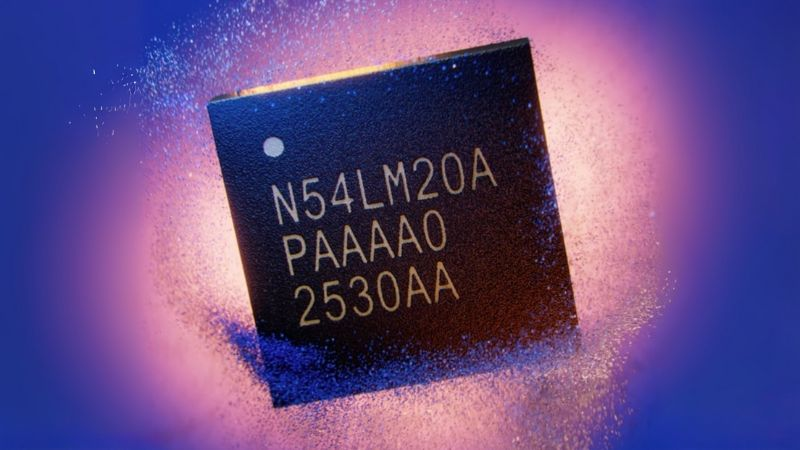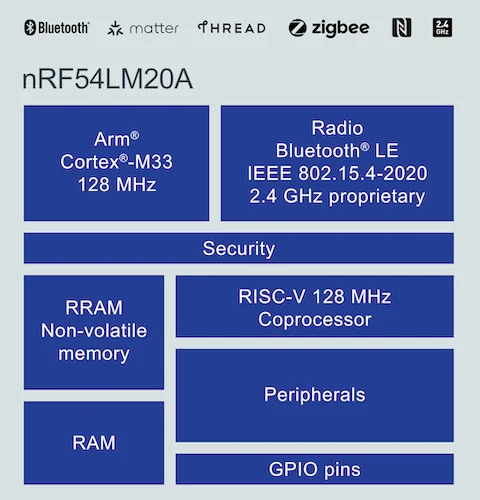Built on Nordic’s 22-nm technology, the latest addition to the nRF54L series promises robust communication, long battery life, and compact designs.
Nordic Semiconductor has announced the nRF54LM20A, the newest member of its nRF54L series of wireless SoCs. With 2 MB of non-volatile memory, 512 KB of RAM, and high-speed USB support, the device addresses the growing complexity of connected devices.

The nRF54LM20A is the latest addition to Nordic's nRF54L series of ultra-low-power wireless SoCs.
Designing reliable wireless devices has become increasingly challenging as connected products demand larger firmware images, richer feature sets, and seamless communication across multiple standards. Where earlier Bluetooth Low Energy (BLE) devices often strained against memory and bandwidth ceilings, the new nRF54LM20A offers a path forward.
Raising the Bar for Reliable Wireless
At its core, the LM20A (datasheet linked) carries a 128-MHz Arm Cortex-M33 CPU with Arm TrustZone security and a dedicated 128-MHz RISC-V coprocessor for offloading time-critical tasks. Its 2-MB, class resistive RAM (RRAM) and 512-KB RAM mean developers can accommodate both the BLE 6.0 protocol stack and application code without resorting to external flash. This extra headroom both simplifies designs and reduces system cost and potential reliability concerns tied to external memory devices.
The SoC’s fourth-generation, 2.4-GHz radio supports Bluetooth LE, IEEE 802.15.4 (for Thread and Zigbee), and proprietary 2.4-GHz protocols up to 4 Mbps. With receive currents as low as 3.4 mA at 1 Mbps BLE and transmit currents around 4.8 mA at 0 dBm, the LM20A retains Nordic’s trademark low-power profile while adding resilience through advanced radio sensitivity and up to +8-dBm output power.
Memory, Interfaces, and I/O
Nordic positions the LM20A above its earlier nRF54L15 and nRF54L10, which top out at 1.5 MB/256 KB and 1.0 MB/192 KB of memory, respectively. The LM20A not only doubles the available RAM but also integrates high-speed USB—a first for the nRF54L line. This addition broadens its appeal to USB-HID applications such as gaming mice, mechanical keyboards, and hybrid wired/wireless peripherals.

The LM20A's key features.
Developers will also find flexibility in the device’s I/O options. The chip supports up to 66 GPIOs in its smallest chip-scale package (CSP98, just 3.67 mm x 3.85 mm) and 35 GPIOs in a 6 mm x 6 mm QFN52 variant. Other on-chip resources include a 14-bit ADC, multiple high-speed serial interfaces, and a system-wide RTC capable of running in low-power modes.
On the security front, Nordic has equipped the LM20A with secure boot, secure DFU, and secure storage, alongside Arm TrustZone hardware isolation. Its CRACEN cryptographic accelerator handles AES-256, SHA-2/SHA-3, RSA-4096, and ECC operations, and physical countermeasures such as glitch detectors, active-shield circuitry, and tamper detection further bolster reliability.
Applications That Push the Limits
The LM20A’s blend of memory, power efficiency, and connectivity is aimed at applications that traditionally strain constrained MCUs. Matter hubs and Thread border routers stand out with their expanding code bases that require large internal flash and RAM, and the LM20A provides enough overhead to handle over-the-air updates without auxiliary memory.
In consumer electronics, the combination of BLE and high-speed USB directly addresses the needs of gaming peripherals and professional HID devices, where users expect sub-millisecond responsiveness whether connected wirelessly or via cable.
Industrial and healthcare developers may also benefit. The inclusion of Bluetooth Channel Sounding in BLE 6.0 unlocks accurate distance measurement for access control, indoor positioning, and secure proximity applications. By embedding this feature natively, Nordic ensures that designers can build advanced presence detection and ranging features without resorting to specialized hardware.
Like other members of the nRF54L family, the LM20A is supported by the nRF Connect SDK, Nordic’s Zephyr-based software platform that includes protocol stacks, drivers, and development tools. Recent SDK releases already support Bluetooth Channel Sounding, Thread, Zigbee, and proprietary 2.4 GHz development, giving engineers a head start on migration. Nordic’s development kits for the nRF54L Series provide access to all key interfaces. Engineers can evaluate the LM20A through project-based early access by contacting Nordic’s sales team.
According to Nordic, the LM20A is currently sampling to select partners, with production availability expected in Q1 2026. That timeline gives designers an early opportunity to evaluate whether the chip’s mix of expanded memory, advanced radio, and security features can simplify their next generation of connected devices.
-
Tel
+86 180 2549 2789 -
Wechat

 BOM
BOM Cart()
Cart() English
English Russia
Russia Korean
Korean
